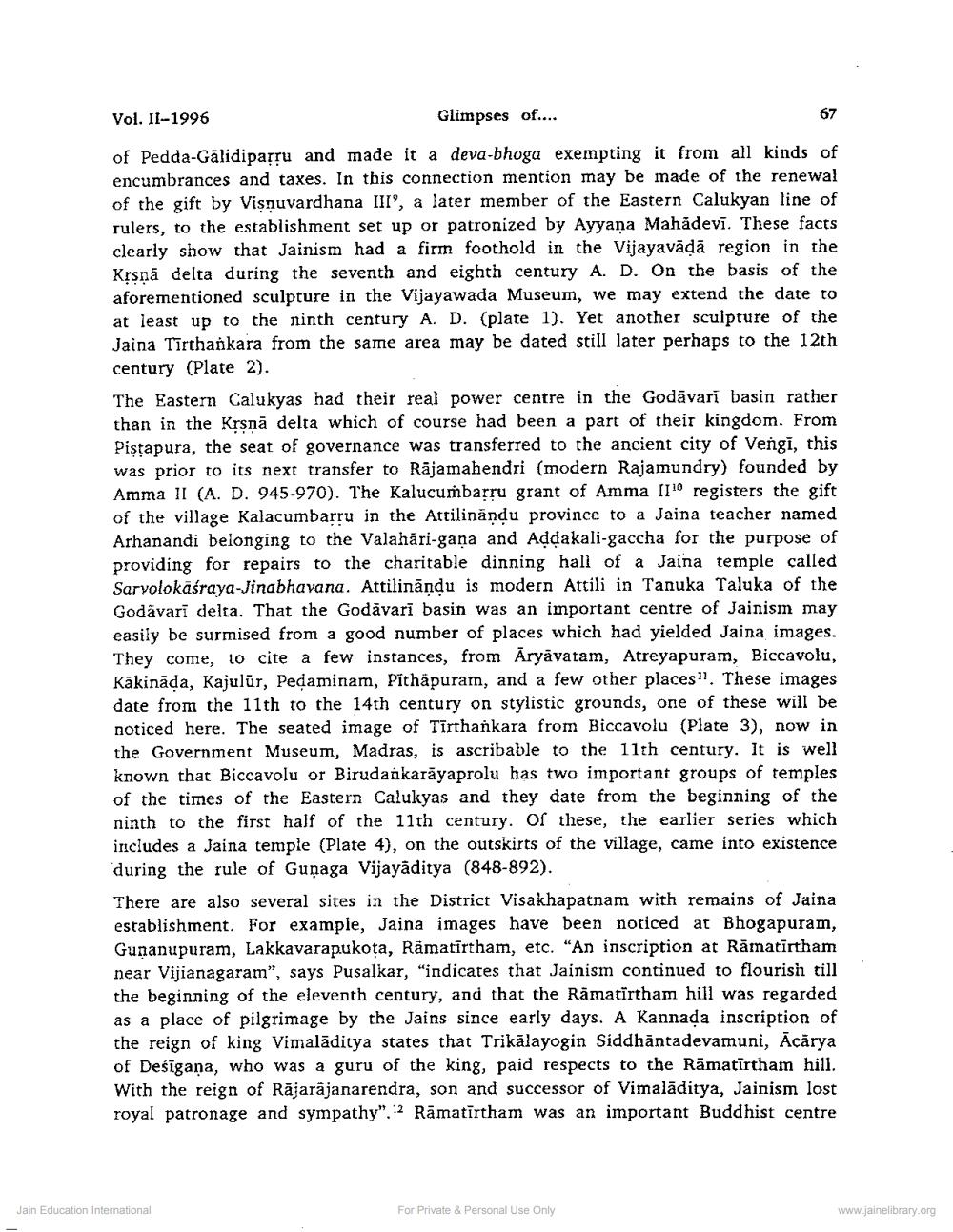Book Title: Glimpses of Jaina Vestiges in Andhradesa Author(s): H Sarkar Publisher: Z_Nirgrantha_1_022701.pdf and Nirgrantha_2_022702.pdf and Nirgrantha_3_022703.pdf View full book textPage 3
________________ Vol. II-1996 Glimpses of.... of Pedda-Gālidiparru and made it a deva-bhoga exempting it from all kinds of encumbrances and taxes. In this connection mention may be made of the renewal of the gift by Vişnuvardhana III', a later member of the Eastern Calukyan line of rulers, to the establishment set up or patronized by Ayyaņa Mahadevi. These facts clearly show that Jainism had a firm foothold in the Vijayavādā region in the Krsnā delta during the seventh and eighth century A. D. On the basis of the aforementioned sculpture in the Vijayawada Museum, we may extend the date to at least up to the ninth century A. D. (plate 1). Yet another sculpture of the Jaina Tīrthankara from the same area may be dated still later perhaps to the 12th century (Plate 2). The Eastern Calukyas had their real power centre in the Godāvari basin rather than in the Krsna delta which of course had been a part of their kingdom. From Pistapura, the seat of governance was transferred to the ancient city of Vengi, this was prior to its next transfer to Rajamahendri (modern Rajamundry) founded by Amma II (A. D. 945-970). The Kalucuṁbarru grant of Amma [110 registers the gift of the village Kalacumbarru in the Attilinăndu province to a Jaina teacher named Arhanandi belonging to the Valahări-gana and Addakali-gaccha for the purpose of providing for repairs to the charitable dinning hall of a Jaina temple called Sarvolokāśraya-Jinabhavana. Attilināņdu is modern Attili in Tanuka Taluka of the Godavari delta. That the Godāvarī basin was an important centre of Jainism may easily be surmised from a good number of places which had yielded Jaina images. They come, to cite a few instances, from Aryāvatam, Atreyapuram, Biccavolu, Käkināda, Kajulur, Pedaminam, Pithapuram, and a few other places". These images date from the 11th to the 14th century on stylistic grounds, one of these will be noticed here. The seated image of Tīrthankara from Biccavolu (Plate 3), now in the Government Museum, Madras, is ascribable to the 11th century. It is well known that Biccavolu or Birudankarāyaprolu has two important groups of temples of the times of the Eastern Calukyas and they date from the beginning of the ninth to the first half of the 11th century. Of these, the earlier series which includes a Jaina temple (Plate 4), on the outskirts of the village, came into existence during the rule of Guñaga Vijayaditya (848-892). There are also several sites in the District Visakhapatnam with remains of Jaina establishment. For example, Jaina images have been noticed at Bhogapuram, Gunanupuram, Lakkavarapukoța, Råmatirtham, etc. "An inscription at Rāmatirtham near Vijianagaram", says Pusalkar, "indicates that Jainism continued to flourish till the beginning of the eleventh century, and that the Rāmatirtham hill was regarded as a place of pilgrimage by the Jains since early days. A Kannada inscription of the reign of king Vimalāditya states that Trikālayogin Siddhāntadevamuni, Ācārya of Desīgana, who was a guru of the king, paid respects to the Rāmatirtham hill. With the reign of Rājarājanarendra, son and successor of Vimalāditya, Jainism lost royal patronage and sympathy". 12 Rāmatirtham was an important Buddhist centre Jain Education International For Private & Personal Use Only www.jainelibrary.orgPage Navigation
1 2 3 4 5 6 7 8
